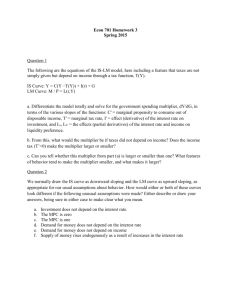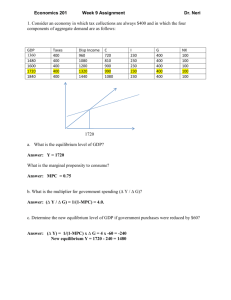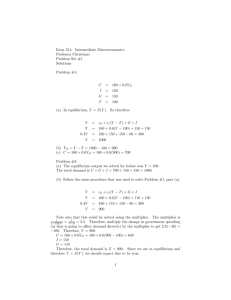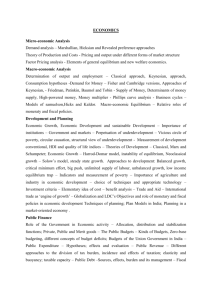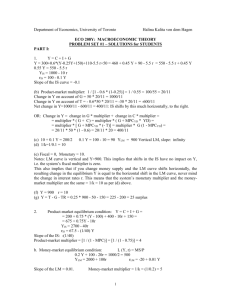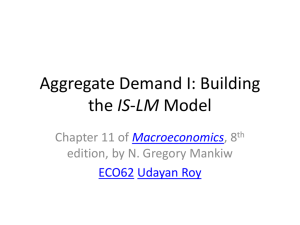14.02 Principles of Macroeconomics Quiz # 1, Answers
advertisement
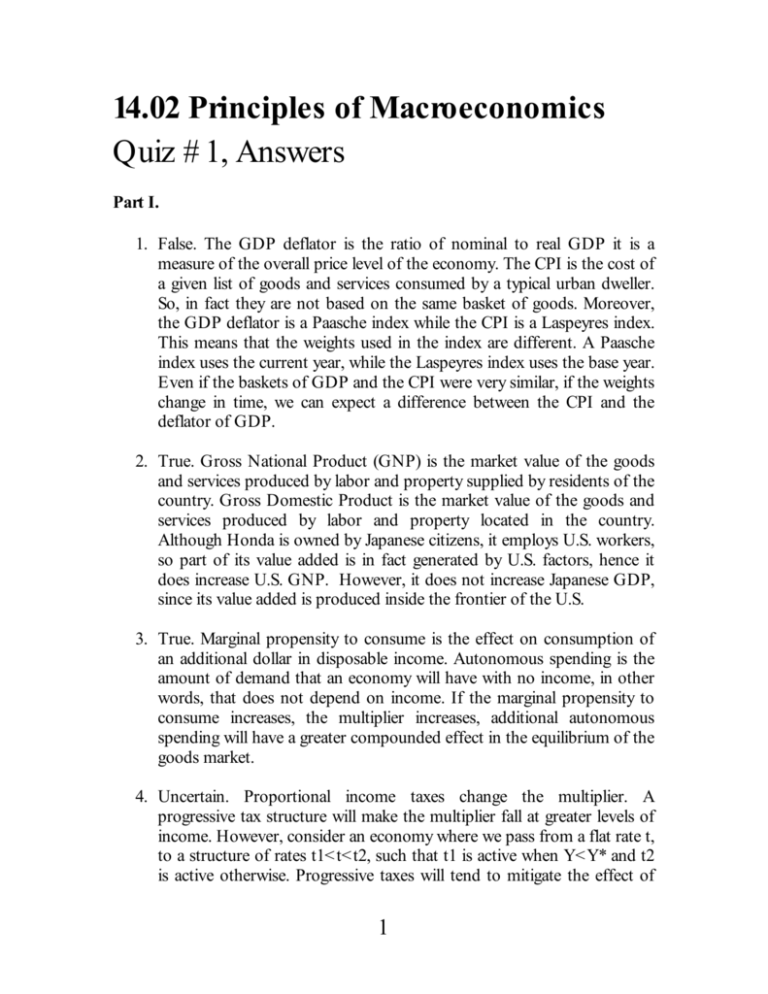
14.02 Principles of Macroeconomics Quiz # 1, Answers Part I. 1. False. The GDP deflator is the ratio of nominal to real GDP it is a measure of the overall price level of the economy. The CPI is the cost of a given list of goods and services consumed by a typical urban dweller. So, in fact they are not based on the same basket of goods. Moreover, the GDP deflator is a Paasche index while the CPI is a Laspeyres index. This means that the weights used in the index are different. A Paasche index uses the current year, while the Laspeyres index uses the base year. Even if the baskets of GDP and the CPI were very similar, if the weights change in time, we can expect a difference between the CPI and the deflator of GDP. 2. True. Gross National Product (GNP) is the market value of the goods and services produced by labor and property supplied by residents of the country. Gross Domestic Product is the market value of the goods and services produced by labor and property located in the country. Although Honda is owned by Japanese citizens, it employs U.S. workers, so part of its value added is in fact generated by U.S. factors, hence it does increase U.S. GNP. However, it does not increase Japanese GDP, since its value added is produced inside the frontier of the U.S. 3. True. Marginal propensity to consume is the effect on consumption of an additional dollar in disposable income. Autonomous spending is the amount of demand that an economy will have with no income, in other words, that does not depend on income. If the marginal propensity to consume increases, the multiplier increases, additional autonomous spending will have a greater compounded effect in the equilibrium of the goods market. 4. Uncertain. Proportional income taxes change the multiplier. A progressive tax structure will make the multiplier fall at greater levels of income. However, consider an economy where we pass from a flat rate t, to a structure of rates t1< t< t2, such that t1 is active when Y< Y* and t2 is active otherwise. Progressive taxes will tend to mitigate the effect of 1 positive shocks to autonomous spending. The effect of Negative shocks on the other hand, could be less mitigated than before. 5. False. The budget deficit is the excess of government expenditures over government spending. An exogenous variable is a variable that is not explained by the model but rather is taken as given. An exogenous shock to exports will lower the equilibrium output of the economy. If government spending I exogenous and the tax rate is fixed, we should expect the government deficit to increase as the governments tax collection falls. 6. False. The tax on ATM transactions does not change the demand for money. Rather, it increases the proportion of money held as currency. This decreases the money multiplier, and therefore, the money supply for a given level of Central Bank money. The fall in money supply leads to a left-ward shift in the LM curve, and an increase in the equilibrium interest rate and a decrease in equilibrium output. 7. True. The money multiplier is the increase in the supply of money resulting from the increase of a unit of high powered money. High powered money or central bank money is the money issued by the central bank, the coins and bills. It is also known as the monetary base. If banks decide to hold less reserves per dollar, they will be in effect creating more money in the economy as they grant more withdrawal rights over a smaller amount of monetary base. 8. False. The money demand is a function that describes the amount of money that is demanded in the economy at every interest rate level. The amount of money is the equilibrium amount of money being held by individuals. If government expands spending and does issue money, it will still have an effect on the money market. Since equilibrium output will increase, the demand for money will expand and the interest rate will rise. With a fixed and exogenous supply of money, the amount of money being held by individuals could not change despite the increase in the money demand. Part II. 1. The IS in this economy will be: 2 i= A (1 − c1 ) − Y b2 b2 slope the IS curve represents the combinations of interest rate levels and output that are consistent with equilibrium in the goods market. 2. The LM in this economy will be: i= m0 − M m1 + Y m2 m2 slope the LM curve represents the combinations of interest rate levels and output that are consistent with equilibrium in the money market. 3. Equilibrium output in the normal year will be: A M − m0 + b m2 Y* = 2 m1 1 − c1 + m2 b2 increased money supply will increase the equilibrium level of Y*. Increased money supply lowers interest rates as wealth moves from the bond market to the money market. The fall in interest rates makes investment increase, hence pushing up the equilibrium level of output. 4. It is fairly obvious that YW A M − (m0 + ∆m0 ) + b2 m2 = m1 1 − c1 + m2 b2 and hence Y * −Y W ∆m0 ∆m0 m2 m2 = = m1 1 − c1 m1 1 1 + + m2 b2 m2 b2 multiplier 3 5. The increase in money demand caused by the war scare, makes interest rates rise for every level of output. The LM moves to the left and upwards. The IS is unaffected and so are the slopes of both curves. The increase in interest rates make investment fall as people move away from bonds towards money. The fall in investment makes equilibrium output fall due to the war scare. 6. An increase in the multiplier will make the difference in the two output levels greater. Graphically the reason is that the IS curve is flatter so that shifts in the LM curve (such as those caused by changes in m0) will have a larger impact. Conceptually, the changes in m0 are changes in the money demand that generate changes in the interest rate and hence in investment. The multiplier tells us how much of an effect on equilibrium output this change in investment demand should have. The effect of the fluctuation of money demand is “blown up” if the multiplier is higher. 7. Conceptually a proportional tax will diminish the multiplier. We have argued in 6 why a smaller multiplier should diminish the difference between the two equilibrium levels of output. Mathematically, the fluctuation of the economy can be shown to be: Y * −Y W ∆m0 m2 = m1 1 − (1 − t )c1 + m2 b2 When the war scare comes, taxes will automatically fall so that consumption does not fall so much as it would otherwise. 8. The slope of the LM does not change. The new IS curve can be shown to be: i= g A' (1 − c1 ) − Y + 1 (Y − Y *) b2 b2 b2 so that when Y= Y*, the new IS is the same as the old one. For Y> Y*, the new IS will have higher interest rate levels for each level of output because a higher demand from government purchases will have to be compensated with a smaller demand for investment which can only be caused with higher interest rates. For Y< Y*, there the new IS curve will have smaller interest rate levels for each level of output because lower government spending will open space for an increased investment 4 demand that can only be generated with lower interest rates. The new IS will be flater than the old one. 9. With a steeper IS curve the effects of shifts of the LM will be larger. The reason is that every time that interest rates are increased by the “war scare” and investment demand falls, the demand from government purchases automatically increases to compensate. 5 This document was created with Win2PDF available at http://www.daneprairie.com. The unregistered version of Win2PDF is for evaluation or non-commercial use only.

